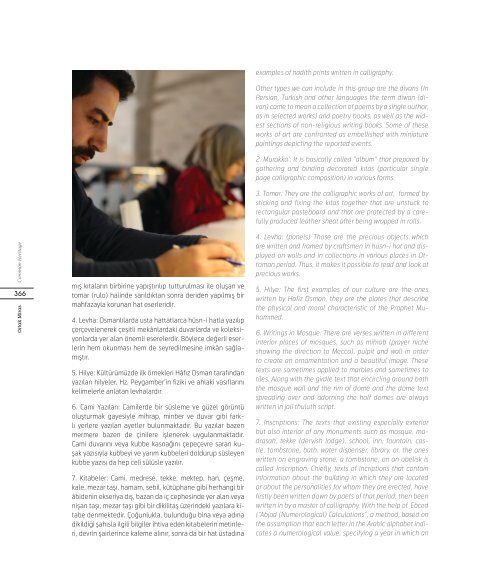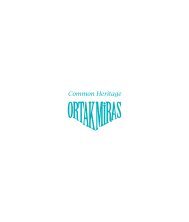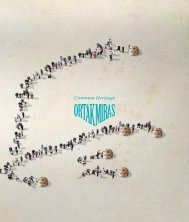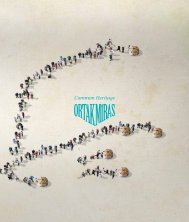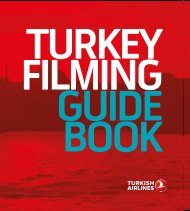- Page 1:
Aynı dil, aynı kültür, aynı ta
- Page 5:
Medeniyet, insanlığın ortak mira
- Page 8 and 9:
Doç. Dr. Gülin ÖĞÜT EKER Bilge
- Page 10 and 11:
Common Heritage 10 Ortak Miras Kole
- Page 12 and 13:
Ortak Miras Common Heritage 12
- Page 14 and 15:
Common Heritage 14 Ortak Miras ğü
- Page 16 and 17:
Common Heritage 16 Ortak Miras kile
- Page 18 and 19:
Vitas sum quasped quassintiae nos e
- Page 20 and 21:
Common Heritage 20 Ortak Miras tün
- Page 22 and 23:
Common Heritage 22 Ortak Miras ği/
- Page 24 and 25:
Common Heritage 24 Ortak Miras da a
- Page 26 and 27:
Common Heritage 26 Ortak Miras kun
- Page 28 and 29:
Common Heritage 28 Ortak Miras geli
- Page 30 and 31:
Common Heritage 30 Ortak Miras sert
- Page 32 and 33:
Common Heritage 32 Ortak Miras Budi
- Page 34 and 35:
Common Heritage 34 Ortak Miras ve k
- Page 36 and 37:
Common Heritage 36 Ortak Miras ve k
- Page 38 and 39:
Prof. Dr. Ali DUYMAZ Bilge Yapım B
- Page 40 and 41:
Common Heritage 40 Ortak Miras Osma
- Page 42 and 43:
Common Heritage 42 Ortak Miras ya,
- Page 44 and 45:
Common Heritage 44 Ortak Miras Vita
- Page 46 and 47:
Common Heritage 46 Ortak Miras dere
- Page 48 and 49:
Common Heritage 48 Ortak Miras göz
- Page 50 and 51:
Common Heritage 50 Ortak Miras yeme
- Page 52 and 53:
Common Heritage 52 Ortak Miras nın
- Page 54 and 55:
Doç. Dr. Gülin ÖĞÜT EKER Bilge
- Page 56 and 57:
Common Heritage 56 Ortak Miras Balk
- Page 58 and 59:
Ortak Miras Common Heritage 58
- Page 60 and 61:
Common Heritage 60 Ortak Miras ilet
- Page 62 and 63:
Common Heritage 62 Ortak Miras semb
- Page 64 and 65:
Common Heritage 64 Ortak Miras Bay
- Page 66 and 67:
Ortak Miras Common Heritage 66
- Page 68 and 69:
Common Heritage 68 Ortak Miras tur
- Page 70 and 71:
Common Heritage 70 Ortak Miras lı
- Page 72 and 73:
Prof. Dr. Olcobay KARATEV Bilge Yap
- Page 74 and 75:
Common Heritage 74 Ortak Miras Oğu
- Page 76 and 77:
Common Heritage 76 Ortak Miras lezz
- Page 78 and 79:
Common Heritage 78 Ortak Miras yaş
- Page 80 and 81:
Ortak Miras Common Heritage 80
- Page 82 and 83:
Common Heritage 82 Ortak Miras kür
- Page 84 and 85:
Common Heritage 84 Ortak Miras bir
- Page 86 and 87:
Common Heritage 86 Ortak Miras Bu d
- Page 88 and 89:
Prof. Dr. Metin EKİCİ Bilge Yapı
- Page 90 and 91:
Common Heritage 90 Ortak Miras Bu m
- Page 92 and 93:
Vitas sum quasped quassintiae nos e
- Page 94 and 95:
Common Heritage 94 Ortak Miras Vita
- Page 96 and 97:
Common Heritage 96 Ortak Miras tari
- Page 98 and 99:
Common Heritage 98 Ortak Miras beyl
- Page 100 and 101:
Common Heritage 100 Ortak Miras 199
- Page 102 and 103:
Common Heritage 102 Ortak Miras dan
- Page 104 and 105:
Common Heritage 104 Ortak Miras 6.
- Page 106 and 107:
Common Heritage 106 Ortak Miras olm
- Page 108 and 109:
Common Heritage 108 Ortak Miras rak
- Page 110 and 111:
Common Heritage 110 Ortak Miras Bun
- Page 112 and 113:
Prof. Dr. Mustafa ARSLAN Bilge Yap
- Page 114 and 115:
Common Heritage 114 Ortak Miras Mü
- Page 116 and 117:
Common Heritage 116 Ortak Miras tad
- Page 118 and 119:
Common Heritage 118 Ortak Miras Kav
- Page 120 and 121:
Common Heritage 120 Ortak Miras “
- Page 122 and 123:
Common Heritage 122 Ortak Miras des
- Page 124 and 125:
Common Heritage 124 Ortak Miras lar
- Page 126 and 127:
Common Heritage 126 Ortak Miras bir
- Page 128 and 129:
Dr. Pınar KARATAŞ Bilge Yapım Va
- Page 130 and 131:
Common Heritage 130 Ortak Miras Kü
- Page 132 and 133:
Common Heritage 132 Ortak Miras mı
- Page 134 and 135:
Vitas sum quasped quassintiae nos e
- Page 136 and 137:
Common Heritage 136 Ortak Miras dâ
- Page 138 and 139:
Common Heritage 138 Ortak Miras yan
- Page 140 and 141:
Common Heritage 140 Ortak Miras zam
- Page 142 and 143:
Common Heritage 142 Ortak Miras kon
- Page 144 and 145:
Common Heritage 144 Ortak Miras dü
- Page 146 and 147:
Common Heritage 146 Ortak Miras de,
- Page 148 and 149:
M.Muhtar KUTLU Bilge Yapım Doğay
- Page 150 and 151:
Common Heritage 150 Ortak Miras Do
- Page 152 and 153:
Common Heritage 152 Ortak Miras zam
- Page 154 and 155:
Vitas sum quasped quassintiae nos e
- Page 156 and 157:
Common Heritage 156 Ortak Miras uyg
- Page 158 and 159:
Common Heritage 158 Ortak Miras bir
- Page 160 and 161:
Common Heritage 160 Ortak Miras yü
- Page 162 and 163:
Common Heritage 162 Ortak Miras yı
- Page 164 and 165:
Öğr.Gör.Dr. Ulanbek ALİMOV Bilg
- Page 166 and 167:
Common Heritage 166 Ortak Miras Avc
- Page 168 and 169:
Ortak Miras Common Heritage 168
- Page 170 and 171:
Common Heritage 170 Ortak Miras oyu
- Page 172 and 173:
Common Heritage 172 Ortak Miras yar
- Page 174 and 175:
Common Heritage 174 Ortak Miras buz
- Page 176 and 177:
Common Heritage 176 Ortak Miras sey
- Page 178 and 179:
Doç. Dr. Fatma KOÇ - Doç. Dr. Em
- Page 180 and 181:
Common Heritage 180 Ortak Miras Far
- Page 182 and 183:
Common Heritage 182 Ortak Miras cak
- Page 184 and 185:
Common Heritage 184 Ortak Miras hay
- Page 186 and 187:
Common Heritage 186 Ortak Miras Çi
- Page 188 and 189:
Common Heritage 188 Ortak Miras nı
- Page 190 and 191:
Ortak Miras Common Heritage 190
- Page 192 and 193:
Common Heritage 192 Ortak Miras Ara
- Page 194 and 195:
Common Heritage 194 Ortak Miras kü
- Page 196 and 197:
Common Heritage 196 Ortak Miras olu
- Page 198 and 199:
Common Heritage 198 Ortak Miras gö
- Page 200 and 201:
Common Heritage 200 Ortak Miras nin
- Page 202 and 203:
Common Heritage 202 Ortak Miras I,
- Page 204 and 205:
Fot.26: Azarbaycan ay ve yıldız m
- Page 206 and 207:
Fot. 29: Koncu Kumaş alt kısmı d
- Page 208 and 209:
Common Heritage 208 Ortak Miras gel
- Page 210 and 211:
Common Heritage 210 Ortak Miras jel
- Page 212 and 213:
Common Heritage 212 Ortak Miras old
- Page 214 and 215:
Common Heritage 214 Ortak Miras •
- Page 216 and 217:
Prof. Dr. Salahaddin BEKKİ Bilge Y
- Page 218 and 219:
Common Heritage 218 Ortak Miras Hal
- Page 220 and 221:
Common Heritage 220 Ortak Miras tü
- Page 222 and 223:
Common Heritage 222 Ortak Miras yap
- Page 224 and 225:
Common Heritage 224 Ortak Miras lad
- Page 226 and 227:
Common Heritage 226 Ortak Miras tuz
- Page 228 and 229:
Common Heritage 228 Ortak Miras has
- Page 230 and 231:
Common Heritage 230 Ortak Miras Hal
- Page 232 and 233:
Common Heritage 232 Ortak Miras Şa
- Page 234 and 235:
Common Heritage 234 Ortak Miras nin
- Page 236 and 237:
Prof. Dr. Fuzuli BAYAT Bilge Yapım
- Page 238 and 239:
Common Heritage 238 Ortak Miras Tas
- Page 240 and 241:
Common Heritage 240 Ortak Miras şi
- Page 242 and 243:
Common Heritage 242 Ortak Miras sem
- Page 244 and 245:
Ortak Miras Common Heritage 244
- Page 246 and 247:
Common Heritage 246 Ortak Miras Mec
- Page 248 and 249:
Common Heritage 248 Ortak Miras Mec
- Page 250 and 251:
Vitas sum quasped quassintiae nos e
- Page 252 and 253:
Common Heritage 252 Ortak Miras gö
- Page 254 and 255:
Common Heritage 254 Ortak Miras nul
- Page 256 and 257:
Common Heritage 256 Ortak Miras Mah
- Page 258 and 259:
Common Heritage 258 Ortak Miras vah
- Page 260 and 261:
Mustafa AKSOY Bilge Yapım Bir tak
- Page 262 and 263:
Common Heritage 262 Ortak Miras Mot
- Page 264 and 265:
Common Heritage 264 Ortak Miras rü
- Page 266 and 267:
Vitas sum quasped quassintiae nos e
- Page 268 and 269:
Common Heritage 268 Ortak Miras Baz
- Page 270 and 271:
Common Heritage 270 Ortak Miras Hal
- Page 272 and 273:
Common Heritage 272 Ortak Miras sor
- Page 274 and 275:
Common Heritage 274 Ortak Miras gö
- Page 276 and 277:
Common Heritage 276 Ortak Miras da
- Page 278 and 279:
Common Heritage 278 Ortak Miras kü
- Page 280 and 281:
Common Heritage 280 Ortak Miras şa
- Page 282 and 283:
Pervin ERGUN Bilge Yapım En yaygı
- Page 284 and 285:
Common Heritage 284 Ortak Miras Tü
- Page 286 and 287:
Common Heritage 286 Ortak Miras Ü
- Page 288 and 289:
Common Heritage 288 Ortak Miras cih
- Page 290 and 291:
Common Heritage 290 Ortak Miras Tü
- Page 292 and 293:
Common Heritage 292 Ortak Miras yo
- Page 294 and 295:
Common Heritage 294 Ortak Miras “
- Page 296 and 297:
Common Heritage 296 Ortak Miras olm
- Page 298 and 299:
Common Heritage 298 Ortak Miras sı
- Page 300 and 301:
Vitas sum quasped quassintiae nos e
- Page 302 and 303:
Common Heritage 302 Ortak Miras lam
- Page 304 and 305:
Common Heritage 304 Ortak Miras tir
- Page 306 and 307:
Ortak Miras Common Heritage 306
- Page 308 and 309:
Common Heritage 308 Ortak Miras oca
- Page 310 and 311:
Common Heritage 310 Ortak Miras ve
- Page 312 and 313:
Prof. Dr. Nebi ÖZDEMİR Bilge Yap
- Page 314 and 315:
Common Heritage 314 Ortak Miras Di
- Page 316 and 317: Common Heritage 316 Ortak Miras ço
- Page 318 and 319: Common Heritage 318 Ortak Miras oyu
- Page 320 and 321: Ortak Miras Common Heritage 320
- Page 322 and 323: Common Heritage 322 Ortak Miras Eve
- Page 324 and 325: Common Heritage 324 Ortak Miras Vit
- Page 326 and 327: Common Heritage 326 Ortak Miras Öz
- Page 328 and 329: Common Heritage 328 Ortak Miras “
- Page 330 and 331: Common Heritage 330 Ortak Miras oyu
- Page 332 and 333: Prof. Dr. Ali BORAN Bilge Yapım Ge
- Page 334 and 335: Common Heritage 334 Ortak Miras Tü
- Page 336 and 337: Common Heritage 336 Ortak Miras Ana
- Page 338 and 339: Common Heritage 338 Ortak Miras Kar
- Page 340 and 341: Common Heritage 340 Ortak Miras des
- Page 342 and 343: Vitas sum quasped quassintiae nos e
- Page 344 and 345: Common Heritage 344 Ortak Miras kez
- Page 346 and 347: Common Heritage 346 Ortak Miras tü
- Page 348 and 349: Ortak Miras Common Heritage 348
- Page 350 and 351: Common Heritage 350 Ortak Miras mim
- Page 352 and 353: Ortak Miras Common Heritage 352
- Page 354 and 355: Common Heritage 354 Ortak Miras Cam
- Page 356 and 357: Common Heritage 356 Ortak Miras sar
- Page 358 and 359: Common Heritage 358 Ortak Miras bü
- Page 360 and 361: Doç. Dr. Hikmet ATİK, Doç. Dr. M
- Page 362 and 363: Common Heritage 362 Ortak Miras Tar
- Page 364 and 365: Common Heritage 364 Ortak Miras yet
- Page 368 and 369: Common Heritage 368 Ortak Miras bun
- Page 370 and 371: Ortak Miras Common Heritage 370
- Page 372 and 373: Common Heritage 372 Ortak Miras lû
- Page 374 and 375: Ortak Miras Common Heritage 374
- Page 376 and 377: Common Heritage 376 Ortak Miras Tü
- Page 378 and 379: Common Heritage 378 Ortak Miras mu
- Page 380 and 381: Prof. Dr. Nebi ÖZDEMİR Bilge Yap
- Page 382 and 383: Common Heritage 382 Ortak Miras Tü
- Page 384 and 385: Common Heritage 384 Ortak Miras le
- Page 386 and 387: Ortak Miras Common Heritage 386
- Page 388 and 389: Common Heritage 388 Ortak Miras dı
- Page 390 and 391: Ortak Miras Common Heritage 390
- Page 392 and 393: Common Heritage 392 Ortak Miras kı
- Page 394 and 395: Common Heritage 394 Ortak Miras Yö
- Page 396 and 397: summer range are performed especial
- Page 398 and 399: Common Heritage 398 Ortak Miras gez
- Page 400 and 401: Doç. Dr. Nebi ÖZDEMİR Bilge Yap
- Page 402 and 403: Common Heritage 402 Ortak Miras Eğ
- Page 404 and 405: Common Heritage 404 Ortak Miras lez
- Page 406 and 407: Common Heritage 406 Ortak Miras tal
- Page 408 and 409: Common Heritage 408 Ortak Miras Tü
- Page 410 and 411: Common Heritage 410 Ortak Miras ağ
- Page 412 and 413: Common Heritage 412 Ortak Miras ort
- Page 414 and 415: Ortak Miras Common Heritage 414
- Page 416 and 417:
Common Heritage 416 Ortak Miras öz
- Page 418 and 419:
Prof. Dr. Ali DUYMAZ Bilge Yapım M
- Page 420 and 421:
Ortak Miras Common Heritage 420
- Page 422 and 423:
Common Heritage 422 Ortak Miras ara
- Page 424 and 425:
Common Heritage 424 Ortak Miras Dah
- Page 426 and 427:
Ortak Miras Common Heritage 426
- Page 428 and 429:
Common Heritage 428 Ortak Miras sav
- Page 430 and 431:
Common Heritage 430 Ortak Miras yat
- Page 432 and 433:
Common Heritage 432 Ortak Miras has
- Page 434 and 435:
Common Heritage 434 Ortak Miras bal
- Page 436 and 437:
Common Heritage 436 Ortak Miras ell
- Page 438 and 439:
Aysen SOYSALDI Bilge Yapım Bir etn
- Page 440 and 441:
Common Heritage 440 Ortak Miras Ort
- Page 442 and 443:
Common Heritage 442 Ortak Miras dik
- Page 444 and 445:
Common Heritage 444 Ortak Miras Tü
- Page 446 and 447:
Ortak Miras Common Heritage 446
- Page 448 and 449:
Common Heritage 448 Ortak Miras Pro
- Page 450 and 451:
Common Heritage 450 Ortak Miras sat
- Page 452 and 453:
Ortak Miras Common Heritage 452
- Page 454 and 455:
Common Heritage 454 Ortak Miras Hal
- Page 456 and 457:
Common Heritage 456 Ortak Miras bul
- Page 458 and 459:
Common Heritage 458 Ortak Miras tan
- Page 460 and 461:
Ortak Miras Common Heritage 460
- Page 462 and 463:
Common Heritage 462 Ortak Miras Fot
- Page 464 and 465:
Ortak Miras Common Heritage 464
- Page 466 and 467:
Common Heritage 466 Ortak Miras çe
- Page 468 and 469:
Dr. Şirin YILMAZ Bilge Yapım kül
- Page 470 and 471:
Common Heritage 470 Ortak Miras Kü
- Page 472 and 473:
Common Heritage 472 Ortak Miras ola
- Page 474 and 475:
Common Heritage 474 Ortak Miras hâ
- Page 476 and 477:
Common Heritage 476 Ortak Miras bu
- Page 478 and 479:
Ortak Miras Common Heritage 478
- Page 480 and 481:
Common Heritage 480 Ortak Miras dir
- Page 482 and 483:
Common Heritage 482 Ortak Miras civ
- Page 484 and 485:
Common Heritage 484 Ortak Miras Dok
- Page 486 and 487:
Common Heritage 486 Ortak Miras İs
- Page 488 and 489:
Common Heritage 488 Ortak Miras yap
- Page 490 and 491:
Common Heritage 490 Ortak Miras yo
- Page 492 and 493:
Common Heritage 492 Ortak Miras zen
- Page 494 and 495:
Yrd. Doç. Dr. Zehra KADERLİ Bilge
- Page 496 and 497:
Common Heritage 496 Ortak Miras İn
- Page 498 and 499:
Common Heritage 498 Ortak Miras Tar
- Page 500 and 501:
Common Heritage 500 Ortak Miras man
- Page 502 and 503:
Common Heritage 502 Ortak Miras Ort
- Page 504 and 505:
Common Heritage 504 Ortak Miras Tü
- Page 506 and 507:
Prof. Dr. Ali DUYMAZ Bilge Yapım C
- Page 508 and 509:
Common Heritage 508 Ortak Miras İs
- Page 510 and 511:
ancılaştırırken “odlu” söz
- Page 512 and 513:
Ortak Miras Common Heritage 512
- Page 514 and 515:
kadar fakir olsa da var eyler” di
- Page 516 and 517:
Common Heritage 516 Ortak Miras ruh
- Page 518 and 519:
de tümüyle değerlendiremeyiz. An
- Page 520 and 521:
zengin fakir ayrımı gözetilmeksi


